The History Of Nissan Bluebird

The Nissan Bluebird is a compact- to medium-sized car launched in 1957. The nameplate still exists today on the Nissan Pulsar-based Nissan Bluebird Sylphy in Japan, and on the U13-based Nissan Bluebird in mainland China.
The Bluebirds traditional competitor was the Toyota Corona from almost the very beginning of the product line.
It is one of the longest-running nameplates from a Japanese automaker. It even spawned the S130 Fairlady Z/ 280ZX, which in turn spawned the Maxima (originally 910 Bluebird/ S130 Fairlady Z based), the 160J/ 710/ Violet/ Auster/ Stanza line, and the US-built Altima line.
Export versions were sold variously as the Datsun 510, Datsun 180B (with 160B and 200B versions) and the Datsun Bluebird. The Nissan Bluebird nameplate began appearing around 1982 as the Datsun marque was phased out in favour of Nissan.
From 1981 to 1985, Australia followed the Japanese convention by calling its car the Bluebird, and had a unique, facelifted rear-wheel-drive version for 1984 and 1985. That car was replaced in 1986 by the Nissan Pintara. It would be replaced by the successive Bluebird, also called Pintara, until 1992; then the range was brought in line with the Japanese model, for the U13 series from 1993 to 1997.
In the United States, the Bluebird was eventually sold as the Nissan Stanza. In 1992, the Stanza became the Nissan Altima. Currently, the Bluebird is not sold in North America; in 1998, the Altima was completely redesigned, becoming a model unique to the North American market.
The Bluebird sold in Europe between 1986 and 1990 was in fact a rebadged Nissan Auster—this was replaced by the Primera in Nissan's European line-up in 1990.
A six-cylinder version called the Maxima was released in the 1980s and became a separate model.
Although Nissan's own materials indicate that the Bluebird name emerged in 1959, some records show that the name first adorned a 988 cm³, 34 hp four-door sedan in 1957, which was part of the company's 210 series. Its engine was based on an Austin design, as Nissan had been building the Austin A50 Cambridge under licence in the 1950s.
The 210 was known for doubling Nissan's production at the time and was the first Nissan to be exported to the United States.
In some markets, this model was exported as the Datsun 1000.
The 210 established an early reputation for reliability, with two of them winning the 1,000 cm³ class in the 1958 Australia Mobilgas Rally.
The 210 had succeeded the 110 series, sold as a two- and four-door sedan and offered from 1955 to 1957. This model bore the Convar or A110 model names and was powered by an 860cm³, 20hp four-cylinder engine. In some respects, the A110 is the forerunner of the modern Bluebird line. Incremental changes were denoted by 112, 113 and 114 codes, with the last model a 113 with a 210 engine.
Subsequent models included the 211 (October 1958) with cosmetic changes.
The Datsun Bluebird which débuted for August 1959 was an all-new car. The 310 series had a 1L engine from the 210 model.
In July 1960, a five-door station wagon was added. By February 1961, a 1.2L overhead-valve engine (codenamed E1) became an option on a higher-trim DX model.
Styling tended to ape larger American cars. A very small number did make it to the United States, but were flops.
In September 1963, Nissan brought the Bluebird up-to-date with boxier styling, apeing the more European designs being produced in the United States. A sporting model, the Bluebird SS, was launched in March 1964, with a tuned 1.2L engine.
Initially, only a four-door sedan and five-door station wagon were in the range, but a two-door was added in September 1964. The two-door SS was launched in February 1965. The two-door was not available in the U.S.
The base engine was enlarged to a 1.3L unit in May 1965 and a 1.6L SSS model was launched the same month. This began a line of famous Nissans in Japan, with the Bluebird SSS a mainstay of the range until its deletion in 2001.
To be more appropriately correct, the early DATSUNs imported to the U.S. were branded as "Datsun", not Nissan. Nissan was the manufacturer, Datsun the marque. An 'early' Datsun is effectively any Datsun made by Nissan prior to the 1968 model year, by U.S. standards. 'Early' would also include the Nissan Patrol, Nissan Silvia (made prior to 1968). Both the Bluebird and Silvia names were used after the 1968 model year was introduced, but were entirely different vehicles and don't belong in an 'early Datsun' category. 'Early' would also include the roadsters (SPL311, and SRL311, also known as 'Fairlady'), as well as the 520 and 521 pickup trucks, both of which were based entirely on pre-1968 models with little change. By the same token, the 'Bluebird' was not labeled thus in the U.S., but designated by the actual model: PL410, PL411, and RL411, along with certain earlier models. This addition more appropriately belongs on an "Early Datsun" or "Datsun 410/ 411 series" dedicated page.
The 510 is arguably the most famous Nissan Bluebird of them all in the US, where the 510 moniker instantly brings this range to mind. Its positive reputation led to the 510 tag being reused there for the unrelated 1978-1981 Nissan Stanza in an effort to capture this range’s glory.
Launched in August 1967, it was one of the most comprehensive Bluebird ranges in terms of body styles: a two-door sedan, a four-door sedan, a five-door station wagon, and a two-door coupé (added in November 1968).
This range became famous for Nissan's rallying successes outside Japan and paved the way for greater Nissan sales internationally together with the famous Datsun 160JSSS aka Datsun Violet( IRS L series engine version of the US market Datsun 710.) which in Japan was already a 70's Datsun with Turbo intake , unmatched condition by any other Datsuns of the era.
In many markets, the Datsun 510 was sold as the Datsun 1300/ 1500/ 1600.In those markets the Datsun 510 was known as Datsun 1300 with the "J" series 1300 engine, Datsun 1500 with the "J" series 1500 engine, push rod over head valve engine, and, Datsun 1600 with the "J" series 1600 engine. (OHV) and leaf sprung ( all 510's in fact, Sedan, Coupe and SW, no IRS 510s in several markets.) In several markets around the world, the Datsun 510 was the small brother of the mighty Datsun 160J SSS aka Datsun Violet. In the US, Nissan reversed the trend, making the Datsun 510 a mighty IRS L series engine car, while the Datsun 160JSSS/ Violet was downplayed into the US market Datsun 710 with leaf spring suspension and protruding bumpers.
In September 1970, the 1.3 and 1.6 L engines were replaced with 1.4 and 1.8 L units. In other parts of the world the 510 was equipped with J series OHV push rod engines . In the US it remained a 1.6.
Australian versions of the Datsun 1600 were delivered either as a full import, or assembled in Australia from local and Japanese parts. These 510 Datsuns were equipped with L 13,14 and 16 engines.
South American versions of the Datsun 510 were delivered with OHV push rod engines J series variety and leaf spring suspensions ( no IRS ) on all models
The PL510 was the most prevalent model, with the 1968 import H510 two door twin SU version arriving in a batch of just a few hundred. Around the world, the J series push rod engined model was most common.
The last of the PL510 series went through Australian assembly lines in 1972, and due to the extensive use for rallying, the cars are now quite hard to find in any reasonable condition.
The 610 series was launched in Japan in August 1971 and was badged as the Bluebird-U. The meaning behind the U suffix is uncertain, but it has been suggested that it was an acronym for either User or Ultra. For the Japanese domestic market, the 610 was pitted against the Toyota Corona MkII. Also in Japan, the 610 was initially sold alongside the 510 but eventually replaced the 510. 610's were available in a 4dr, 2dr hardtop (HT), and five-door wagon. Trim levels in Japan were GL (Grand Luxe), SSS (Super Sports Sedan), DX (Deluxe) or STD (Standard). The 610 borrowed its suspension and drive train from the outgoing 510. Thus all 610's were equipped with the Nissan L-Series inline engines. Likewise, the 610 4dr & 2dr retained the class-leading, independent rear trailing arm design, while the wagon reused the rear live axle with leaf springs from the 510 wagon. In many export markets, including UK, Europe & Australia, the 610 was badged as the 160B or 180B with respect to particular engine displacement. From 1973-74, the USA was the only market outside of Japan to have its 610 HT models equipped with the unique, six-bulb tail lights that covered the entire rear panel, requiring the license plate to be mounted below the rear bumper. Most 610's world- wide came equipped with either a 4spd manual or 3spd automatic transmission, but a 5spd manual transmission was available in the Japan & Australia markets. As with the 510, SSS trim included misc. sport options and a higher output engine with twin-Hitachi carburetors. A Japan-only SSS-E model was equipped with Bosch EFI, and so was one of the first, mass-produced Nissan vehicles to be sold without a carburetor. Another 610 never exported was the inline-six 2000 GT(SAMEBLUE..SAME meaning Shark in Japanese). It came with stretched front end to accommodate the longer engine, but this model was not available in a wagon.
A minor upgrade to the front suspension (offset strut tops) for the 610 led to slightly improved handling before the introduction of the 810.
Related Models
Shortly after the introduction of the 610, Nissan launched a new line of slightly smaller cars utilizing parts and styling cues from the 610. This new line of cars was sold in various markets as the 140J/ 160J, Violet, or 710 and later as the Stanza. The use of the 710 name was a source of confustion because it implied that the model was either a larger, upscale version of the 610 (it was the opposite) or a newer model in the Bluebird line.
For more details on this topic, see Nissan Stanza.Racing History
A 610 4dr participated in the 1972 & 1973 East African Safari Rally. Bob Sharp drove his 610 HT race car to 2nd place overall in the SCCA B Sedan Championship for 1973 & 1974. The car achieved a first place for the 1976 SCCA B-Sedan Championship but with Elliot Forbes-Robinson driving.
See also: Datsun 200BThe 810 was introduced in July 1976. Engine options were carried over but a 1.4L was reintroduced in August 1978. The 160B, 180B and 200B were sold in export markets, with Australian magazine Wheels calling the 200B 'a 180B with 20 more mistakes.' Styling was an evolution of the 610's, with slightly squared off features but retaining a slight "coke bottle". No two-door sedan was available, but the four-door sedan, two-door hardtop coupé ( SSS Coupe) and five-door station wagon were offered.
In New Zealand the sedan models were assembled for a time alongside the Hillman Avenger, Hillman Hunter and Mitsubishi Galant by Todd Motors of Porirua, until 1978 when Nissan opened a purpose-built assembly plant for its cars in Auckland.
The Datsun 180B makes a cameo appearance as a monster truck in Pirate Baby's Cabana Battle Street Fight 2006.
From Wikipedia, the free encyclopedia
More About Nissan Bluebird
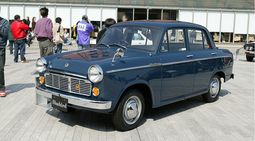
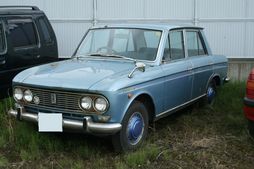
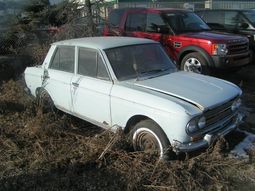
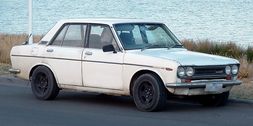
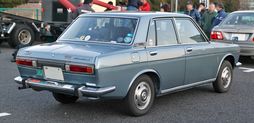
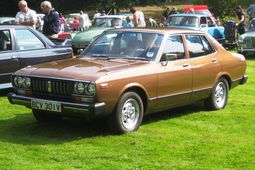
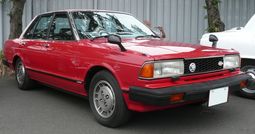
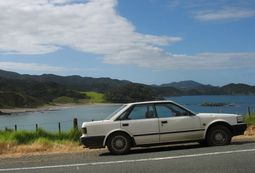
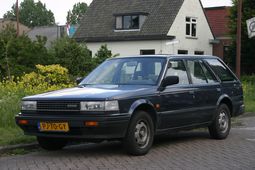
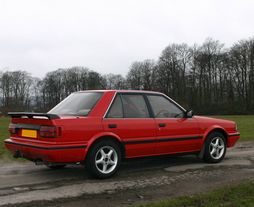
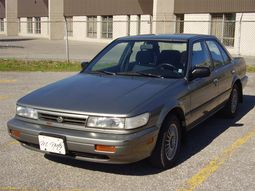
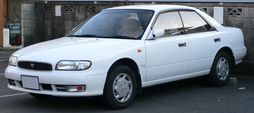
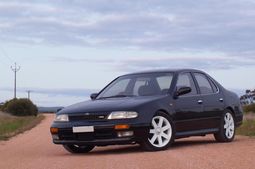
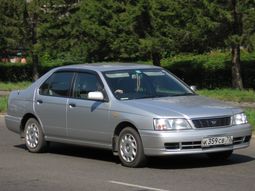
|